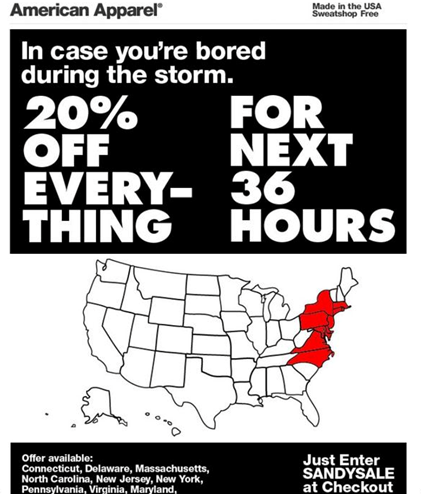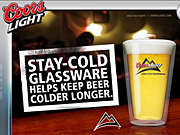When marketeres come up with an advertising campaign, they have to take many aspects into consideration. Simply praising or trying to appeal to a certain target market is of not much use if, at the same time, the advertisement it openly criticized as offensive. The entire campaign will backfire and hurt the company’s reputation with the ultimate consequence of decreased profit or losses.
Sometimes, even big companies make the mistake of stepping over the line in favor of what they obviously considered a good marketing tactic: This advertisement by American Apparel was discussed when Hurricane Sandy hit the American Northeast in November last year. It is a perfect example of a campaign backfiring due to lack of ethical concern.
 After this ad had been sent to all e-mail subscribers in the Northeast area, people affected by the Hurricane immediately started to express their disappointment in the company’s marketing methods. What was supposed to be an incentive to go shopping during the hurricane turned into a marketing desaster. American Apparel CEO Dov Charney responded to the criticism saying “We don’t think it was offensive” (1) and continued “It wasn’t that serious”. Maybe it was not to him or even from an objective point of view, but marketing is rarely treated like an objective science. Taking advantage of a current event for promotion can turn out well if the right tone is found.
After this ad had been sent to all e-mail subscribers in the Northeast area, people affected by the Hurricane immediately started to express their disappointment in the company’s marketing methods. What was supposed to be an incentive to go shopping during the hurricane turned into a marketing desaster. American Apparel CEO Dov Charney responded to the criticism saying “We don’t think it was offensive” (1) and continued “It wasn’t that serious”. Maybe it was not to him or even from an objective point of view, but marketing is rarely treated like an objective science. Taking advantage of a current event for promotion can turn out well if the right tone is found.
For example, half a decade ago Coors Light beer gained 3% market share as a result of their marketing campaigns that focused on coldness and refreshment during the 2006 heat have.
In this case, however, American Apparel did not hit the right tone. “In case you’re bored during the storm” was not appropriate for a weather condition that caused 253 casulties in 7 countries and turned out to be the 2nd costliest hurricane in US history with approximately $65.6 billion in damage. American Apparel suffered, too, as their share price fell from $1.12 on the 29th of October (the day the email was sent) to $0.88 on November 16th, a low that could not be recovered until early January 2013.
In conclusion, I think that it is not necessary to completely avoid to take advantage of current events; but American Apparel should have chosen a different approach to marketing Hurricane Sandy. One of the comments under the article suggested that instead of offering 20% discount, American Apparel could have offered to donate 20% of their sales during a certain period to people who lost their homes. Not only would this have prevented people from having moral discomfort with their campaign, but it could have contributed positively to their reputation.
(1) Marketing Ethics, American Apparel & Hurricane Sandy, bostinno.com, November 5th 2012, written by Paul Watson
http://bostinno.com/channels/marketing-ethics-american-apparel-hurricane-sandy/
